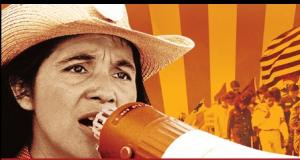Dolores Huerta: The Life and Work of a 20th Century Activist

Students will explore the life, primary contributions, and core activism strategies of the activist Dolores Huerta. Students will use primary sources to connect what they’ve already learned about civil rights, worker rights, and activist movements in 20th century U.S. history. Students will examine text excerpts from primary sources, photographs, and news stories from the life and work of Dolores Huerta.
Students will break into small discussion groups twice during this lesson. First, they will debrief their core knowledge of the significance of the various aspects of Dolores Huerta’s life and activist work, and then they will select a primary and secondary source to discuss in small groups.
Two 30-min class blocks or one 60-min block, with two nights of homework between class sessions if the class is broken into two lessons.
- Students will read, analyze, and respond to primary sources related to the life and work of Dolores Huerta.
- Students will work collaboratively to reflect on their understanding of the sources and the time period and deepen their comprehension of the impact of Dolores Huerta and other farmworker’s rights activists.
- Students will make connections between the primary sources and the wider movement for farmworker rights.
- Students will discuss their opinions and reflections with source-based references in small groups and respond to their peers’ thoughts and observations.
Students should understand the civil rights and union/worker rights movements in the United States. Students should be able to place Dolores Huerta’s life and work into the larger narrative of civil rights movements and farmworker activism in the 1960s and 1970s, especially in California.
- Collaborative Notetaking Guide (What We Wonder)
- Dolores Huerta: Historical Background Reading (Secondary Source)
- Primary Source #1: Dolores Huerta’s National Farm Workers Association speech at the march and rally in Sacramento on April 10, 1966.
- Source #2: National Portrait Gallery painting of Huerta and accompanying explanation.
30 minutes and homework
1. In pairs or small groups, review the two primary sources. Students will fill in the taking notes on their Dolores Huerta notetaking template.
2. Create a Headline:
- Ask students to compose a headline based on the themes and patterns they’ve identified and noted on their notetaking template from the curated collection of sources. The students should not re-use any source title as the headline. All headlines should include a subject and action word/verb and should be shorter than 15 words.
- Students will write their headlines on a class flip chart at the front of the room or use a shared Google doc as a class collection of headlines
3. Provide Evidence
- Students will write three points of evidence from their notetaking guide (primary and secondary sources) to justify their headline selection.
4. Share Headlines
- Students will walk around the class and examine the flip chart paper with the headlines and evidence-based justifications, or read and review the shared Google doc with the headlines and points of evidence.
Class Extensions or Homework
Collaborative Notetaking and Presentation
- Present the class with an essential guiding question such as “What do these sources teach us about the movement for farmworker rights and the role that Dolores Huerta played in leading the movement?”
- Instruct students that they will be looking at and/or reaching each source with the guiding question in mind and they should look to identify patterns and themes across all of the primary sources
- Use collaborative notetaking guide to keep track of themes and patterns
Primary Source #1: U.S. House Resolution 37, Expressing the sense of the House of Representatives that all workers deserve fair treatment and safe working conditions, and honoring Dolores Huerta. (2007)
Source #2: Celebrating One Life, Library of Congress (audio/video)
Source #3: “Dolores Huerta Receives Her Due” (song and article)
Source #4: Department of Labor Hall of Honor Inductee announcement
Source #5: Dolores Huerta Speech at the Children’s Defense Fund (2012)
Source #6: Biography of an Activist (National Women’s History Museum)
Source # 7: Dolores Huerta Foundation (modern work of Huerta)
Standards- C3 and Common Core
D1.5.9-12. Determine the kinds of sources that will help answer compelling and supporting questions, taking into consideration multiple points of view represented in the sources, the types of sources available, and the potential uses of the sources.
D2.Civ.7.9-12. Apply civic virtues and democratic principles when working with others.
D2.Civ.14.9-12. Analyze historical, contemporary, and emerging means of changing societies, promoting the common good, and protecting rights.
D2.His.2.9-12. Analyze change and continuity in historical eras.
D2.His.5.9-12. Analyze how historical contexts shaped and continue to shape people’s perspectives.
Common Core:
CCSS.ELA-LITERACY.RH.11-12.1: Cite specific textual evidence to support analysis of primary and secondary sources, connecting insights gained from specific details to an understanding of the text as a whole.
CCSS.ELA-LITERACY.RH.11-12.7: Integrate and evaluate multiple sources of information presented in diverse formats and media (e.g., visually, quantitatively, as well as in words) to address a question or solve a problem.
CCSS.ELA-LITERACY.RH.11-12.10: By the end of grade 12, read and comprehend history/social studies texts in the grades 11-CCR text complexity band independently and proficiently.
